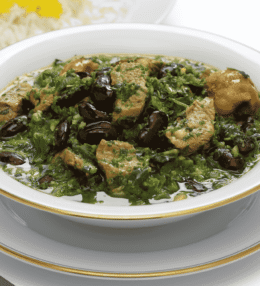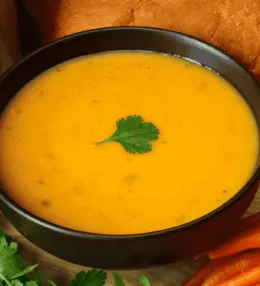
- View
Iranian kitchens hold dishes that defy expectations, combinations so unexpected that they challenge everything you thought you knew about how flavours should work together. Fesenjan stands among these culinary marvels, a stew that makes converts of nearly everyone who tries it properly prepared.
This isn’t your everyday comfort food, though it certainly brings comfort to those who grew up with it. Fesenjan combines ground walnuts and pomegranate molasses into a thick, glossy sauce that cloaks tender pieces of chicken or duck in burgundy splendour.
The dish appears at celebrations and family gatherings throughout Iran, particularly during autumn when pomegranates hang heavy on trees and walnuts get cracked open at kitchen tables. Yet it’s equally at home on a quiet weeknight, simmering away whilst filling the house with its unmistakable aroma.
What makes Fesenjan truly special is its unapologetic character. The stew doesn’t try to please everyone with safe, middle of the road flavours. Instead, it presents a bold combination of sweet, sour and savoury that demands your full attention.
What Is Fesenjan?
Fesenjan is a traditional Persian stew built around two fundamental ingredients: finely ground walnuts and pomegranate molasses. These create a sauce unlike anything else in the culinary world, thick enough to coat the back of a spoon yet somehow still elegant.
The protein varies by region and occasion. Chicken remains the common choice for everyday cooking, whilst duck appears at more formal gatherings. Some families prepare it with lamb meatballs, particularly in northern provinces where this variation has deep roots.
The cooking process transforms simple ingredients into something remarkable. Ground walnuts get toasted gently, releasing their oils and developing a deeper, nuttier flavour. They then simmer slowly with broth, breaking down into a paste that forms the stew’s foundation.
Pomegranate molasses joins later, its concentrated tartness cutting through the richness of the walnuts. The meat cooks low and slow until it practically falls apart, absorbing all those complex flavours whilst contributing its own savoury depth to the sauce.
The finished stew should be thick and velvety, with a colour somewhere between deep amber and mahogany. It’s traditionally served over Persian rice, preferably with a crispy tahdig bottom that provides textural contrast to the stew’s smoothness.
Ingredients and Taste
Fesenjan requires just a handful of ingredients, though their quality matters enormously. Fresh walnuts form the base, ground fine enough to create that signature creamy texture. Pomegranate molasses provides the essential sweet and sour character that defines the dish.
Chicken pieces, usually bone in thighs and legs, offer the protein, though duck or lamb work beautifully. Onions get sautéed until golden, adding sweetness and depth. Sugar balances the tartness, whilst saffron lends its golden hue and distinctive aroma to some versions.
Cinnamon and turmeric appear in many recipes, adding warmth and earthiness. Some cooks include a touch of cardamom or a splash of rose water, particularly for special occasions. The ingredient list stays relatively short, but each component plays a vital role.
The taste of Fesenjan challenges simple description because it exists in multiple flavour dimensions simultaneously. Your first spoonful reveals the nuttiness of walnuts, toasted and rich, coating your palate with their creamy texture.
Then comes the pomegranate molasses, sharp and tangy, waking up your taste buds with its bright acidity. But wait, there’s sweetness too, rounding out those sour notes and preventing the dish from becoming too aggressive.
The chicken or duck adds savoury depth, its fat melding with the walnut paste to create an impossibly silky consistency. Underneath everything runs a current of warmth from the spices, never dominating but always present.
What surprises many people is how the flavours develop as you eat. The initial tartness mellows, the nuttiness deepens, and suddenly you understand why Iranians have cherished this dish for generations. It’s complex without being complicated, bold without being harsh.
A Taste of History
Fesenjan’s roots stretch back to ancient Persia, long before the Islamic conquest, when the region’s cuisine had already developed remarkable sophistication. The dish likely originated in northern Iran, particularly around Gilan and Mazandaran, where pomegranates and walnuts grow abundantly.
Historical texts suggest versions of this stew appeared at royal banquets during the Safavid dynasty, though common people had been cooking similar dishes for centuries before that. The combination of fruits, nuts and meat reflects a culinary tradition unique to Persian cooking.
The name itself comes from “fesenjoon,” derived from the Persian word for the specific type of nut used. Over time, regional variations emerged across Iran. Southern cooks might add more sugar, creating a sweeter version, whilst northern recipes tend towards greater tartness.
Fesenjan held particular significance during Yalda, the winter solstice celebration where families gather to eat pomegranates and read poetry through the longest night of the year. The ruby seeds scattered over the stew symbolise life persisting through darkness.
Jewish Persian communities developed their own cherished version, often serving it during Rosh Hashanah to symbolise abundance and sweetness for the new year. This speaks to how the dish transcends religious boundaries whilst remaining deeply Iranian in character.
Through waves of emigration, Fesenjan travelled with Iranian families to new lands, becoming a way to maintain connection with their heritage. Today, you’ll find it simmering in kitchens from Los Angeles to London, each pot holding memories of home.
How to Make Fesenjan (Walnut Pomegranate Stew)
Fesenjan is a beloved Persian stew that captures the soul of Iranian cooking with its deep, rich balance of sweet and sour flavours. Ground walnuts simmer slowly with pomegranate molasses to create a velvety sauce that coats tender chicken or duck. The secret lies in patience and gentle cooking. See the recipe card at the bottom for printable directions
Ingredients
- 500 g chicken thighs (bone-in, skinless)
- 250 g walnuts, finely ground
- 1 large onion, finely chopped
- 2 tbsp vegetable oil or ghee
- 2 tbsp pomegranate molasses
- 2 cups chicken stock or water
- 1 tbsp sugar (optional, to balance tartness)
- ½ tsp turmeric powder
- Salt and black pepper, to taste
- Fresh pomegranate seeds, for garnish
Cooking Instructions
Step 1: Toast the walnuts
Place the ground walnuts in a large dry pan over low heat. Stir constantly for 5–7 minutes until they release a nutty aroma and turn slightly golden. Be careful not to burn them, as this will add bitterness.
Step 2: Prepare the walnut base
Gradually add 1 cup of warm water to the toasted walnuts, stirring well to form a thick paste. Allow the mixture to simmer gently for 20 minutes, stirring occasionally to prevent sticking. This step releases the natural oils and deepens the flavour.
Step 3: Sauté the onions
In a separate pan, heat the vegetable oil or ghee over medium heat. Add the chopped onions and cook until golden brown. Sprinkle in the turmeric powder and stir briefly to enhance colour and aroma.
Step 4: Combine chicken and onions
Add the chicken pieces to the onions and brown lightly on all sides. This seals in moisture and enriches the stew’s depth. Season with salt and pepper, ensuring the spices coat the chicken evenly.
Step 5: Merge the mixtures
Transfer the sautéed chicken and onions into the walnut pot. Pour in the remaining cup of chicken stock, stirring to combine. Simmer gently over low heat for 30 minutes, allowing the flavours to begin blending.
Step 6: Add the pomegranate molasses
Stir in the pomegranate molasses and sugar (if using). Adjust the balance of sweet and sour to your preference by tasting the sauce. Cover and continue cooking for another 45–60 minutes until the stew thickens and the oil separates on top.
Step 7: Adjust consistency
If the stew becomes too thick, add a splash of water or stock. The ideal texture is smooth and rich, thick enough to coat the back of a spoon. Taste and adjust seasoning as needed.
Step 8: Rest and develop flavour
Remove from the heat and allow the stew to rest for 10 minutes before serving. This short rest helps the flavours settle and intensify, resulting in a more rounded taste.
Step 9: For serving
Spoon the Fesenjan into a shallow serving dish. Garnish with fresh pomegranate seeds for a bright contrast. Serve hot alongside steamed Persian rice (chelo) or saffron rice.
Step 10: Presentation
Fesenjan is often served as part of festive or family meals. Pair it with crisp herbs and flatbread for a traditional Persian touch. Its deep, tangy sweetness makes it unforgettable.
Variations and Substitutions
- Meat options: Duck or lamb can replace chicken for a richer flavour.
- Vegetarian version: Replace the chicken with roasted aubergine or mushrooms.
- Pomegranate molasses substitute: Mix 1 cup pomegranate juice with 2 tbsp lemon juice and reduce over low heat until thickened.
- Walnuts: Almonds or pecans can be used in part if walnuts are unavailable, though the flavour will differ.
Cooking Tips for Perfect Fesenjan
- Toast the walnuts slowly to release oils and prevent bitterness.
- Use low heat throughout; Fesenjan benefits from gentle, patient cooking.
- Add pomegranate molasses gradually and taste as you go to balance tartness.
- Allow the stew to rest before serving for a deeper, more integrated flavour.
- Store leftovers overnight; the flavour improves as it sits.
How to Store and Reheat
Storing Properly
Fesenjan actually improves after a day or two in the refrigerator, as the flavours meld and deepen. Let the stew cool completely before transferring it to an airtight container. It will keep safely for up to four days when refrigerated.
The walnut oil may separate and rise to the surface during storage, which is perfectly normal. Simply stir it back in when reheating. If you’ve made a large batch, Fesenjan freezes beautifully for up to three months without losing its character.
Freeze in portion sized containers for convenient future meals. Make sure to leave some headspace as the stew will expand slightly when frozen. Label with the date so you can track freshness and use older batches first.
Reheating Methods
The stovetop offers the best results for reheating Fesenjan. Transfer the stew to a heavy bottomed pot over low heat, stirring occasionally to prevent sticking. Add a splash of water or broth if the sauce has thickened too much during storage.
Heat gently for about 15 to 20 minutes until warmed through completely. Rushing this process with high heat can cause the walnut paste to separate and turn grainy, so patience pays off. The slow reheat also allows the flavours to bloom again.
Microwave reheating works in a pinch, though results are less ideal. Use a microwave safe container and heat in two minute intervals, stirring between each round. Cover loosely to prevent splattering whilst allowing some steam to escape.
Serving Suggestions After Storage
Freshly cooked rice makes the perfect accompaniment to reheated Fesenjan. The stew’s rich sauce needs something neutral and fluffy to balance its intensity. Some people like adding fresh pomegranate seeds on top just before serving for a burst of fresh tartness.
A simple herb platter with fresh mint, basil and tarragon cuts through the richness nicely. Torshi, Persian pickled vegetables, also provides acidic contrast that refreshes your palate between bites of the dense, flavourful stew.

Fesenjan (Walnut Pomegranate Stew)
Ingredients
- 500 g chicken thighs bone-in, skinless
- 250 g walnuts finely ground
- 1 large onion finely chopped
- 2 tbsp vegetable oil or ghee
- 2 tbsp pomegranate molasses
- 2 cups chicken stock or water
- 1 tbsp sugar optional, to balance tartness
- ½ tsp turmeric powder
- Salt and black pepper to taste
- Fresh pomegranate seeds for garnish
Instructions
- Place the ground walnuts in a large dry pan over low heat. Stir constantly for 5–7 minutes until they release a nutty aroma and turn slightly golden. Be careful not to burn them, as this will add bitterness.
- Gradually add 1 cup of warm water to the toasted walnuts, stirring well to form a thick paste. Allow the mixture to simmer gently for 20 minutes, stirring occasionally to prevent sticking. This step releases the natural oils and deepens the flavour.
- In a separate pan, heat the vegetable oil or ghee over medium heat. Add the chopped onions and cook until golden brown. Sprinkle in the turmeric powder and stir briefly to enhance colour and aroma.
- Add the chicken pieces to the onions and brown lightly on all sides. This seals in moisture and enriches the stew’s depth. Season with salt and pepper, ensuring the spices coat the chicken evenly.
- Transfer the sautéed chicken and onions into the walnut pot. Pour in the remaining cup of chicken stock, stirring to combine. Simmer gently over low heat for 30 minutes, allowing the flavours to begin blending.
- Stir in the pomegranate molasses and sugar (if using). Adjust the balance of sweet and sour to your preference by tasting the sauce. Cover and continue cooking for another 45–60 minutes until the stew thickens and the oil separates on top.
- If the stew becomes too thick, add a splash of water or stock. The ideal texture is smooth and rich, thick enough to coat the back of a spoon. Taste and adjust seasoning as needed.
- Remove from the heat and allow the stew to rest for 10 minutes before serving. This short rest helps the flavours settle and intensify, resulting in a more rounded taste.
- Spoon the Fesenjan into a shallow serving dish. Garnish with fresh pomegranate seeds for a bright contrast. Serve hot alongside steamed Persian rice (chelo) or saffron rice.
- Fesenjan is often served as part of festive or family meals. Pair it with crisp herbs and flatbread for a traditional Persian touch. Its deep, tangy sweetness makes it unforgettable.
Nutrition
You May Also Like







Leave a Review